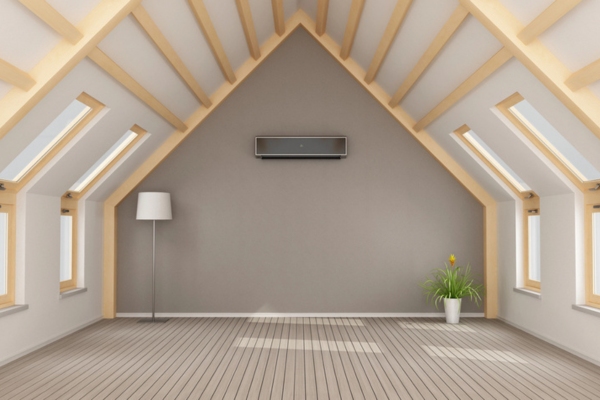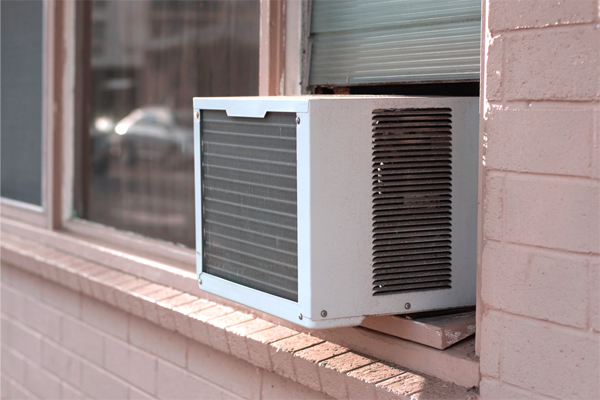Elevate Your Comfort: Selecting an Efficient Attic Air Conditioner

Considering transforming your attic into a functional area involves addressing the challenge of maintaining a comfortable temperature. Understandably, the goal is to achieve this without incurring excessive cooling costs, striving for efficient comfort. Choosing the ideal attic air conditioner unit demands attention to vital details, such as the unit’s dimensions, energy efficiency, the installation process, and how well it integrates with your current HVAC system.
Understanding these elements is crucial for informed decision-making. This article from R.F. Ohl will guide you through the critical considerations for choosing the right air conditioner for your attic, highlighting the features requiring careful evaluation. Let’s explore the vital characteristics you need to consider.
What You Should Be Looking For In An Attic Air Conditioner?
Contents
Attics offer a distinctive challenge for cooling systems. Pick an air conditioner engineered specifically for attic spaces. Ensure you’re up to date with local building codes and regulations for attic AC installations to adhere to compliance and safety standards. For the best outcomes, consult with a knowledgeable HVAC contractor.
Sizing & Capacity of Your Air Conditioner

Collaborate with an HVAC professional to determine the necessary cooling capacity for your attic. Considerations such as the attic’s size, insulation levels, and the overall heat load play a critical role. Select an air conditioner that efficiently cools your space without being overburdened or falling short.
Stay cool and save on energy costs with R.F. Ohl’s efficient attic air conditioning solutions. Call us today to learn more about our home cooling systems.
Energy Efficiency & AC SEER Rating
Choosing an energy-efficient air conditioner is vital to lowering electricity costs and reducing environmental footprint. Focus on models boasting a high Seasonal Energy Efficiency Ratio (SEER) rating, which signifies greater energy efficiency.
Compact Design for Attic AC Units
Given the often restricted space in attics, selecting an air conditioner with a compact design is essential. A smaller unit will fit better and simplify the installation and maintenance process.
Ductless or Mini-Split Systems for Attics

Attics must often be equipped with the ductwork required for conventional central air systems. A ductless or mini-split air conditioner featuring an external unit connected to one or several indoor units is a viable alternative. These systems stand out for their adaptability and ease of attic installation, eliminating the need for extensive modifications. Additionally, they boast high SEER ratings, reduced running costs, and exceptional comfort levels.
Trust our experienced technicians to install the perfect air conditioning system tailored to your needs. Call R.F. Ohl today!
Managing Condensation

Attics may face condensation challenges due to their susceptibility to elevated humidity. To avert moisture-related complications, opt for a cooling solution equipped with efficient condensation management tools, such as condensate pumps or drainage systems. Inquiring with your local HVAC provider on this matter can offer further guidance and assurance.
Noise Levels of Air Conditioners
The noise produced by an air conditioner is an important consideration, especially if your attic is near living areas. Seek out models designed with noise-dampening technologies, like insulated compressor compartments or variable-speed fans, to ensure a quieter operation and reduce disturbance.
The Importance of Installing an Attic Air Conditioner

Equipping your attic with an air conditioning unit is essential for achieving and maintaining a comfortable climate throughout your home. Attics are notorious for trapping excessive heat, rendering them unusable and even impacting the temperature balance in the rest of your living spaces.
With an attic air conditioner, you can:
- Transform your attic into a practical storage area,
- Repurpose your attic as additional living space,
- Alleviate the load on your primary cooling system, ensuring efficiency and longevity.
Ensure a comfortable living space year-round with our professional attic air conditioner installations. Contact R.F. Ohl today!
Air Conditioner Options for Attic Installation

Selecting the right air conditioner for your attic involves considering the unique needs and limitations of the area. Here are four types of air conditioning units that are well-suited for attic spaces:
Ducted Split System
Comprising a central unit linked to ductwork that extends throughout your house, including the attic, this system typically places the central unit outdoors or in a service area. It delivers cooled air to various rooms through vents and ducts. Ideal for more extensive attics or cooling several rooms within the attic, it’s crucial that there is ample space for duct installation and that the attic is well-insulated to prevent energy loss.
Ductless Mini-Split System
This system is favored for attic spaces where installing ductwork could be more practical. Ductless mini-split systems include an external condenser and one or more indoor air-handling units situated within the attic. These indoor units link to the outdoor component via refrigerant lines, needing merely a tiny opening through the attic wall for installation.
Ductless mini-splits support zone-specific cooling to precisely manage temperatures in different attic areas. Their benefits include high energy efficiency, straightforward installation, and low noise levels, making them an excellent choice for attic environments.
Portable Air Conditioner
Portable AC units stand out for their mobility and ease of installation, making them a viable option for smaller attics or short-term cooling requirements. These self-contained systems usually feature an exhaust hose that must be directed outside via a window or a designated opening in the attic.
While installation is straightforward, portable air conditioners may be less efficient and perform less well than more permanent solutions. Their need for correct venting to expel hot air from the attic space limits their suitability. Given these considerations, they are generally not recommended for those seeking long-term, high-efficiency attic cooling solutions.
Through-the-Wall AC Unit

Designed to be mounted in an exterior wall, through-the-wall air conditioners are independent units featuring an integrated compressor and cooling mechanism. They require a wall opening for external ventilation. These units match smaller attics or designated areas within the attic needing cooling, providing a compact installation solution.
Despite their easy installation and space efficiency, these air conditioners are noisy, are more costly to operate, and can foster mold growth that can potentially degrade indoor air quality. Given these drawbacks, industry specialists often need to find more modern systems. HVAC professionals typically recommend more contemporary and efficient options, like ductless mini-split systems.
The Critical Role of Insulation and Sealing for Attic AC Systems

Ensuring your attic is well-insulated and sealed is vital to maximizing the efficiency of your air conditioning system. Insulation acts as a thermal barrier, minimizing heat transfer between your home’s attic and other parts. This containment of cooled air within living areas lessens the demand for air conditioning units, leading to significant energy savings.
Sealing is equally essential in preventing air leakage and infiltration within the attic. Air leaks manifest through openings, fissures, or areas lacking proper sealant, leading to the escape of conditioned air and the intrusion of unconditioned air. By addressing these leaks and sealing them effectively, the attic becomes more enclosed, enhancing the air conditioner’s efficiency. Furthermore, sealing improves air distribution, guaranteeing consistent cooling across the attic space.
Effective insulation and sealing are also crucial in managing moisture and preventing condensation issues that may result in mold development, structural harm, and diminished insulation performance. Keeping the attic dry and well-sealed fosters a healthier living space and reduces the likelihood of expensive repair needs. By adopting these strategies, you boost the efficiency and durability of your attic air conditioning system and contribute to a more comfortable and eco-friendly home environment.
Conclusion
Considering all the key aspects of attic air conditioners we’ve explored is critical for a seamless installation. Considerations like effective temperature management, energy conservation, safeguarding stored items, moisture regulation, and robust insulation and sealing are paramount.
Engaging with a reputable HVAC contractor is advisable to navigate these considerations skillfully. Their expertise will help you choose the appropriate air conditioning system, ensure it is the right size, professionally install it, and fine-tune its operation for your attic. By seeking professional advice, you’re sure to make knowledgeable choices, culminating in an attic that’s both comfortably cool and energy-efficient.
Call R.F. Ohl for Your HVAC Needs
R.F. Ohl is the premier heating and cooling service provider in Northeastern Pennsylvania, boasting a team of skilled and certified technicians adept in HVAC maintenance, repair, installation, and replacement. We’re committed to excellence, ensuring top-quality service for every client.
Understanding the importance of a comfortable and energy-efficient home, R.F. Ohl offers the most competitive service rates. Whether you need a repair, maintenance, or a new installation, our experts will provide tailored solutions that respect your budget, backed by our satisfaction guarantee.
Call R.F. Ohl to book a service or get a free in-home estimate. We offer unparalleled HVAC services that aim to exceed your expectations.
Click here to contact us today or give us a call at (610) 377-1098 if you have any questions. Click the link to view our service area.

Related Articles: